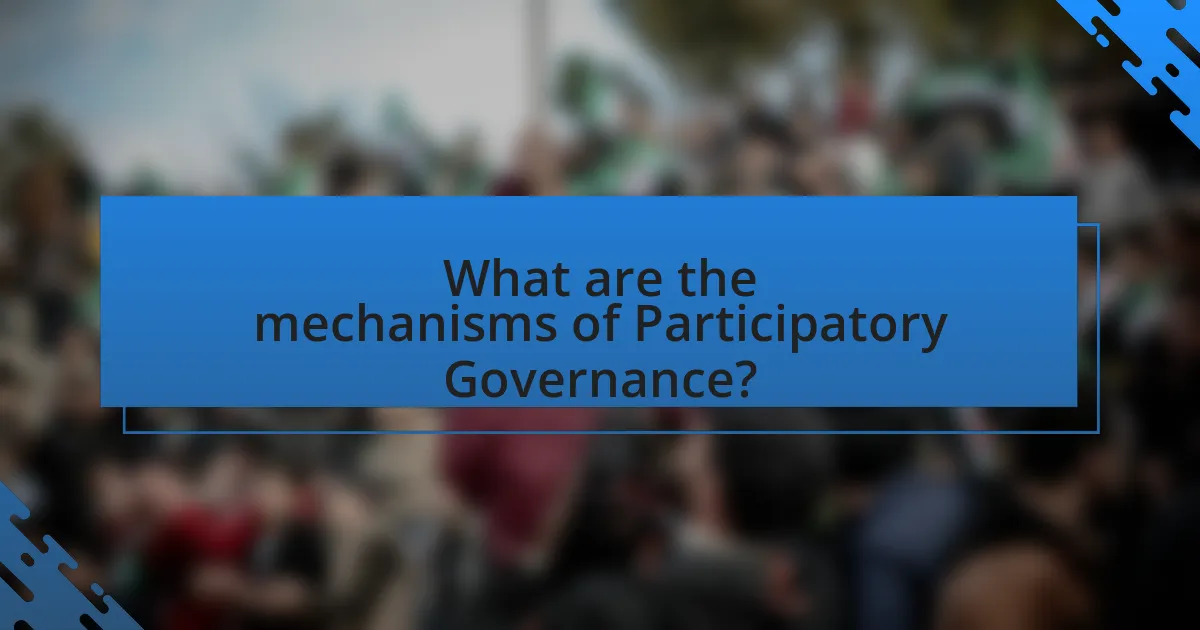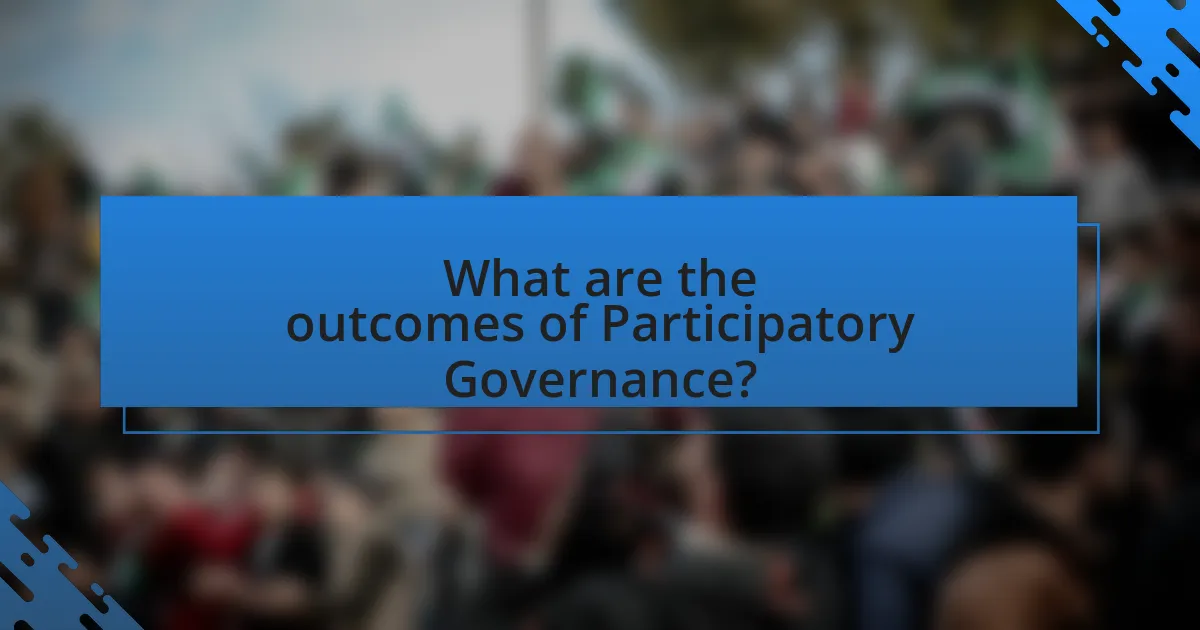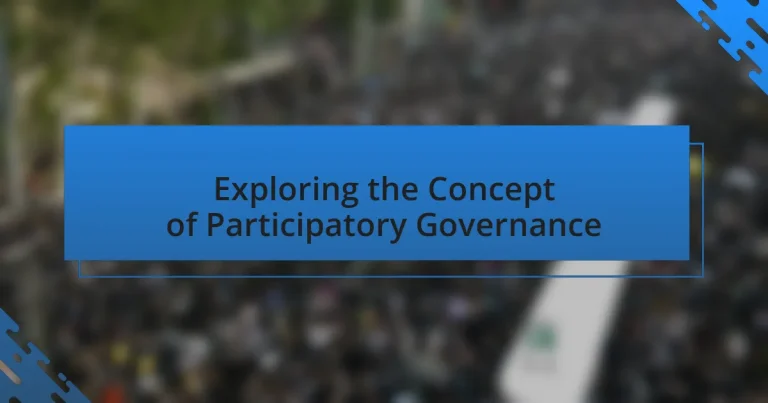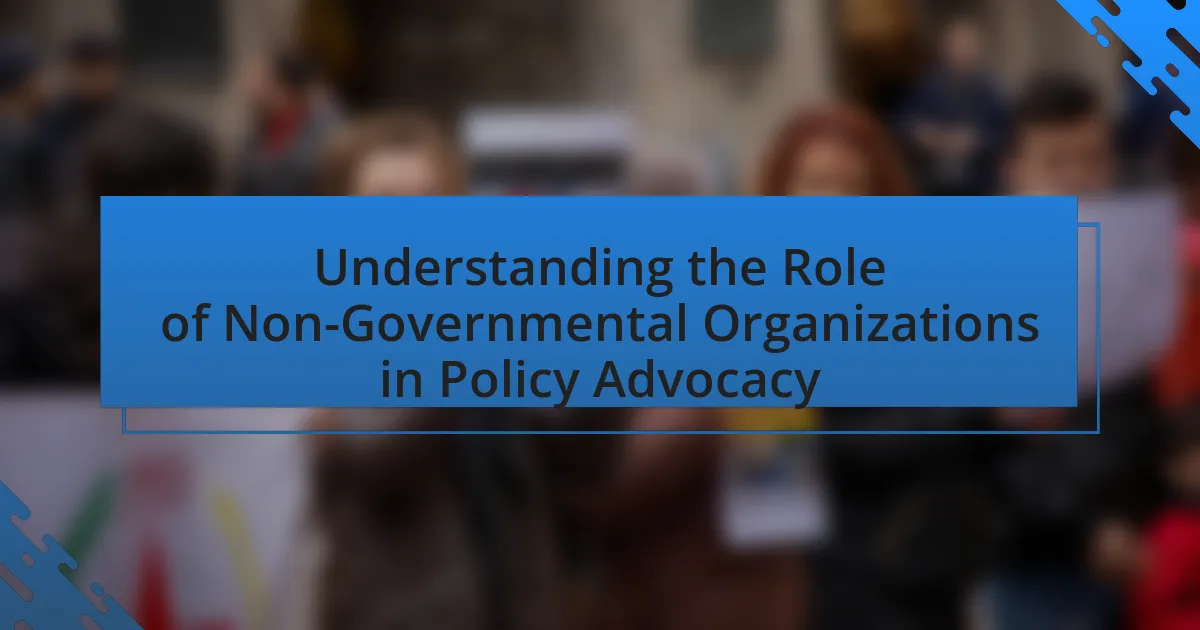Participatory governance is a collaborative decision-making model that actively involves citizens and various stakeholders in shaping policies and programs that impact their lives. This article explores the principles, mechanisms, and historical roots of participatory governance, highlighting its differences from traditional governance models and the importance of inclusivity. It examines the role of social movements and democratic theories in shaping participatory practices, as well as the challenges and barriers to effective citizen engagement. Additionally, the article discusses the outcomes of participatory governance, including enhanced civic engagement and improved policy-making, while identifying future trends and innovations that may influence citizen participation in governance.

What is Participatory Governance?
Participatory governance is a collaborative approach to decision-making that involves various stakeholders, including citizens, in the governance process. This model emphasizes the active engagement of individuals and communities in shaping policies and programs that affect their lives, thereby enhancing transparency and accountability in government actions. Research indicates that participatory governance can lead to improved public trust and more effective policy outcomes, as evidenced by case studies in countries like Brazil and participatory budgeting initiatives that have demonstrated increased civic engagement and resource allocation efficiency.
How does Participatory Governance differ from traditional governance models?
Participatory governance differs from traditional governance models by emphasizing active involvement of citizens in decision-making processes. In traditional governance, decisions are typically made by elected officials or bureaucrats with limited public input, whereas participatory governance encourages collaboration between government and citizens, fostering transparency and accountability. Evidence of this shift can be seen in initiatives like participatory budgeting, which allows community members to directly influence budget allocations, demonstrating a tangible impact of citizen engagement on policy outcomes.
What are the key principles of Participatory Governance?
The key principles of Participatory Governance include inclusiveness, transparency, accountability, and collaboration. Inclusiveness ensures that diverse stakeholders, including marginalized groups, have a voice in decision-making processes. Transparency involves open communication and access to information, allowing stakeholders to understand how decisions are made. Accountability requires that decision-makers are answerable to the public, fostering trust and responsibility. Collaboration emphasizes partnerships among government, civil society, and citizens to co-create solutions. These principles are supported by various studies, such as the World Bank’s report on participatory governance, which highlights that effective participation leads to better governance outcomes and increased public trust.
Why is inclusivity important in Participatory Governance?
Inclusivity is important in participatory governance because it ensures that diverse voices and perspectives are represented in decision-making processes. This representation leads to more equitable outcomes, as it allows marginalized groups to influence policies that affect their lives. Research indicates that inclusive governance can enhance public trust and legitimacy, as seen in studies showing that communities with higher levels of participation report greater satisfaction with local governance. Furthermore, inclusivity fosters innovation and problem-solving by integrating a wider range of ideas and experiences, ultimately leading to more effective governance.
What are the historical roots of Participatory Governance?
Participatory governance has its historical roots in ancient democratic practices, particularly in city-states like Athens, where citizens directly engaged in decision-making processes. This model of governance emphasized the involvement of individuals in political discourse and policy formulation, laying the groundwork for modern participatory frameworks. The evolution of participatory governance continued through the Enlightenment, where philosophers like Rousseau advocated for the social contract and collective decision-making, further influencing democratic ideals. Additionally, the 20th century saw the rise of community organizing and grassroots movements, which emphasized citizen participation in governance as a means to address social inequalities and enhance democratic legitimacy. These historical developments collectively shaped the principles and practices of participatory governance as recognized today.
How have social movements influenced the development of Participatory Governance?
Social movements have significantly influenced the development of Participatory Governance by advocating for greater citizen engagement and accountability in decision-making processes. These movements, such as the civil rights movement and environmental activism, have highlighted the need for inclusive governance structures that reflect diverse community interests. For instance, the civil rights movement in the 1960s pushed for policies that ensured marginalized voices were heard in political processes, leading to reforms that incorporated public participation mechanisms. Additionally, the rise of global social movements in the 21st century, like the Occupy Wall Street movement, has further emphasized the importance of participatory approaches in addressing social inequalities and fostering democratic governance. This influence is evidenced by the adoption of participatory budgeting in cities worldwide, which allows citizens to directly decide on budget allocations, demonstrating a shift towards more inclusive governance practices driven by social movements.
What role do democratic theories play in Participatory Governance?
Democratic theories play a crucial role in participatory governance by providing the foundational principles that guide citizen engagement and decision-making processes. These theories emphasize the importance of inclusivity, equality, and accountability, which are essential for fostering active participation among diverse community members. For instance, deliberative democracy, a prominent democratic theory, advocates for open dialogue and collective reasoning, ensuring that all voices are heard and considered in governance. This approach enhances legitimacy and trust in public institutions, as evidenced by case studies in participatory budgeting initiatives where citizen involvement has led to more equitable resource allocation. Thus, democratic theories not only inform the structure of participatory governance but also enhance its effectiveness and responsiveness to community needs.

What are the mechanisms of Participatory Governance?
Participatory governance mechanisms include public consultations, participatory budgeting, citizen advisory boards, and collaborative decision-making processes. These mechanisms facilitate direct involvement of citizens in governance, allowing them to influence policy and resource allocation. For instance, public consultations enable community members to provide input on proposed policies, while participatory budgeting allows citizens to decide on budget allocations for local projects. Research shows that these mechanisms enhance transparency, accountability, and civic engagement, leading to more responsive governance.
How do citizens engage in Participatory Governance?
Citizens engage in participatory governance by actively participating in decision-making processes that affect their communities. This engagement can take various forms, including attending public meetings, joining advisory boards, participating in community forums, and utilizing digital platforms for feedback and discussion. Research indicates that when citizens are involved in governance, such as through participatory budgeting initiatives, they can influence resource allocation and policy decisions, leading to more responsive and accountable governance. For example, the city of Porto Alegre in Brazil has successfully implemented participatory budgeting since 1989, allowing residents to directly decide on budget priorities, which has resulted in increased public satisfaction and improved social equity.
What tools and platforms facilitate citizen participation?
Tools and platforms that facilitate citizen participation include online surveys, social media, participatory budgeting software, and community engagement platforms. Online surveys, such as SurveyMonkey, allow citizens to provide feedback on policies and initiatives, while social media platforms like Facebook and Twitter enable real-time communication between citizens and government officials. Participatory budgeting software, such as Balancing Act, empowers citizens to directly influence budget allocations in their communities. Community engagement platforms, like CitizenLab, provide a space for dialogue and collaboration between citizens and local governments. These tools enhance transparency and inclusivity in governance, fostering a more engaged citizenry.
How can technology enhance participatory processes?
Technology can enhance participatory processes by facilitating greater access to information and enabling real-time communication among stakeholders. Digital platforms, such as social media and online forums, allow diverse groups to engage in discussions, share ideas, and provide feedback efficiently. For instance, a study by the Pew Research Center found that 69% of adults in the U.S. use social media, which can serve as a tool for mobilizing community engagement and fostering dialogue. Additionally, tools like online surveys and collaborative software enable participants to contribute their perspectives and vote on decisions, thereby increasing transparency and inclusivity in governance.
What challenges does Participatory Governance face?
Participatory governance faces several challenges, including limited public engagement, power imbalances, and bureaucratic resistance. Limited public engagement occurs when citizens lack awareness or interest in participating, which can lead to unrepresentative decision-making. Power imbalances arise when certain groups dominate the process, marginalizing voices of less powerful stakeholders. Bureaucratic resistance often manifests as reluctance from government officials to share authority or adapt to participatory methods, hindering effective collaboration. These challenges can undermine the effectiveness and legitimacy of participatory governance initiatives.
What are the common barriers to effective citizen engagement?
Common barriers to effective citizen engagement include lack of awareness, limited access to information, and insufficient opportunities for participation. Lack of awareness often stems from inadequate outreach efforts by governing bodies, which can lead to citizens being uninformed about engagement opportunities. Limited access to information can occur due to complex bureaucratic processes or digital divides, preventing certain demographics from participating. Insufficient opportunities for participation may arise when engagement initiatives are poorly designed or fail to consider diverse community needs, resulting in low turnout and engagement rates. These barriers collectively hinder the effectiveness of participatory governance by isolating citizens from decision-making processes.
How can power dynamics affect participation in governance?
Power dynamics significantly influence participation in governance by determining who has the authority to make decisions and who is marginalized in the process. When power is concentrated in the hands of a few, it often leads to unequal representation, where the voices of less powerful groups are overlooked or ignored. For instance, in many democratic systems, marginalized communities may face barriers such as lack of access to information, resources, or platforms to express their views, which diminishes their ability to engage effectively in governance. Research indicates that inclusive governance structures that actively address power imbalances can enhance participation rates and lead to more equitable outcomes, as seen in participatory budgeting initiatives in cities like Porto Alegre, Brazil, where citizen involvement has led to improved public services and community trust.

What are the outcomes of Participatory Governance?
Participatory governance leads to enhanced civic engagement, improved policy outcomes, and increased trust in government. By involving citizens in decision-making processes, participatory governance fosters a sense of ownership and accountability among stakeholders. Research indicates that communities with participatory governance structures often experience better alignment between public policies and the needs of the population, resulting in more effective and relevant services. For instance, a study by the World Bank found that participatory budgeting initiatives can lead to increased public investment in areas prioritized by citizens, demonstrating a direct correlation between citizen involvement and positive community development outcomes.
How does Participatory Governance impact policy-making?
Participatory governance significantly enhances policy-making by incorporating diverse stakeholder input, leading to more informed and representative decisions. This approach fosters transparency and accountability, as citizens actively engage in the decision-making process, ensuring that policies reflect the needs and preferences of the community. Research indicates that participatory governance can improve policy outcomes; for instance, a study by the World Bank found that inclusive decision-making processes lead to higher satisfaction with public services and increased trust in government institutions.
What evidence exists to support the effectiveness of Participatory Governance?
Evidence supporting the effectiveness of Participatory Governance includes improved public service delivery, increased citizen trust, and enhanced policy outcomes. For instance, a study by the World Bank in 2015 demonstrated that participatory budgeting in Brazil led to a 20% increase in public investment in health and education in the municipalities that implemented it. Additionally, research published in the Journal of Public Administration Research and Theory in 2018 found that participatory governance initiatives in various countries resulted in higher levels of citizen satisfaction and trust in government institutions. These findings indicate that participatory governance can lead to tangible improvements in governance and public welfare.
How does citizen involvement influence public trust in government?
Citizen involvement significantly enhances public trust in government by fostering transparency and accountability. When citizens actively participate in decision-making processes, they feel a sense of ownership and engagement, which leads to increased confidence in governmental actions. Research indicates that communities with higher levels of civic engagement report greater trust in their local governments, as evidenced by a study conducted by the National Civic League, which found that participatory budgeting initiatives led to a 20% increase in trust among residents. This correlation demonstrates that when citizens are involved, they perceive government actions as more legitimate and responsive to their needs, thereby strengthening the overall trust in public institutions.
What best practices can enhance Participatory Governance?
Best practices that can enhance Participatory Governance include fostering inclusive stakeholder engagement, ensuring transparency in decision-making processes, and utilizing technology for communication and collaboration. Inclusive stakeholder engagement allows diverse community voices to be heard, which is essential for effective governance. For instance, research by the World Bank indicates that participatory approaches can lead to better project outcomes and increased public trust. Transparency in decision-making builds accountability and encourages citizen participation, as evidenced by studies showing that open government initiatives can improve civic engagement. Additionally, leveraging technology, such as online platforms for public consultations, can facilitate broader participation and streamline feedback mechanisms, as demonstrated by successful e-governance initiatives in various countries.
How can governments create an environment conducive to participation?
Governments can create an environment conducive to participation by implementing inclusive policies that encourage citizen engagement. For instance, establishing platforms for public dialogue, such as town hall meetings and online forums, allows citizens to voice their opinions and contribute to decision-making processes. Research indicates that countries with higher levels of civic engagement, such as Sweden and Denmark, have seen improved governance outcomes, demonstrating that active participation leads to more responsive and accountable government actions. Additionally, providing education and resources about civic rights and responsibilities empowers citizens to engage effectively, further enhancing participatory governance.
What role do education and awareness play in fostering participation?
Education and awareness are crucial in fostering participation by equipping individuals with the knowledge and understanding necessary to engage effectively in governance processes. When people are educated about their rights, responsibilities, and the mechanisms of governance, they are more likely to participate actively in decision-making. For instance, studies have shown that communities with higher levels of civic education experience increased voter turnout and engagement in local governance initiatives. This correlation highlights that informed citizens are more empowered to voice their opinions and influence policies, thereby enhancing the overall quality of participatory governance.
What future trends are emerging in Participatory Governance?
Future trends in participatory governance include increased digital engagement, enhanced data transparency, and a focus on inclusivity. Digital platforms are becoming essential for citizen participation, allowing for real-time feedback and collaboration in decision-making processes. For instance, cities like Barcelona and Amsterdam have implemented online platforms that facilitate citizen input on urban planning, demonstrating the effectiveness of technology in fostering engagement. Additionally, there is a growing emphasis on data transparency, where governments are expected to share information openly, enabling citizens to hold officials accountable. This trend is supported by initiatives such as the Open Government Partnership, which promotes transparency and citizen involvement in governance. Lastly, inclusivity is gaining traction, with efforts to ensure marginalized communities have a voice in governance, as seen in participatory budgeting projects that prioritize underrepresented groups. These trends indicate a shift towards more democratic and responsive governance structures.
How might globalization affect Participatory Governance practices?
Globalization can enhance Participatory Governance practices by facilitating the exchange of ideas and best practices across borders. This interconnectedness allows local governments to adopt successful participatory strategies from other regions, leading to improved citizen engagement and transparency. For instance, the rise of digital platforms, driven by globalization, enables broader participation in governance processes, as seen in countries like Estonia, where e-governance initiatives have increased public involvement. Additionally, globalization can create pressure for governments to adopt participatory practices to meet international standards and expectations, as evidenced by the increasing emphasis on citizen participation in global governance frameworks such as the United Nations Sustainable Development Goals.
What innovations are shaping the future of citizen engagement?
Innovations shaping the future of citizen engagement include digital platforms, artificial intelligence, and data analytics. Digital platforms, such as social media and mobile applications, facilitate real-time communication between citizens and government entities, enhancing transparency and responsiveness. Artificial intelligence enables personalized interactions and predictive analytics, allowing governments to anticipate citizen needs and tailor services accordingly. Data analytics provides insights into public sentiment and engagement patterns, helping policymakers make informed decisions. For instance, cities using platforms like Nextdoor have reported increased community participation and collaboration on local issues, demonstrating the effectiveness of these innovations in fostering participatory governance.
What practical steps can individuals take to engage in Participatory Governance?
Individuals can engage in Participatory Governance by actively participating in local decision-making processes. This includes attending town hall meetings, where community members can voice their opinions and influence policies. Additionally, individuals can join local advocacy groups that focus on specific issues, allowing them to collaborate with others to push for change. Volunteering for community boards or committees also provides a platform for individuals to contribute to governance discussions and decisions. Research shows that communities with higher citizen engagement in governance tend to have better outcomes in public services and community satisfaction, highlighting the importance of individual involvement in these processes.





